- Our Company
- Interest Free Finance
- Your Security
- Customer Service
- More Info
Magnificent Jewels
Wittelsbach-Graff
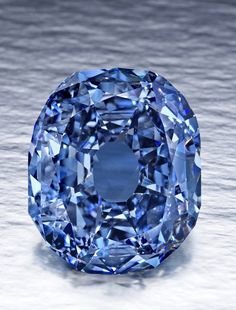
A diamond with a recent history of controversy Der Blaue Wittelsbacher – as originally known – was a 35.56ct Fancy Deep Greyish-Blue, VS2 diamond. With historical links as early as 1664, it has been part of both the Austrian
and Bavarian crown jewels and had a few chips and nicks associated with its long history. In 2008 Laurence Graff purchased the diamond for a cool £16.4million, at the time, the highest price ever paid at auction for any diamond. In 2010 he announced he had had it re-cut. Renaming it the Wittelsbach-Graff, the now 4ct lighter diamond was submitted for re-grading by GIA, and returned as an incredible Fancy Deep Blue, Flawless.
Critics admonished Graff for this, saying the diamond was now “unrecognisable” as the Wittelsbach and he had ruined its near 400 years history. Quite certainly however, Mr Graff was unperturbed by this as he sold the Wittelsbach-Graff to the emir of Qatar in June 2011 for at least £47million.
Millennium Star

The Millennium Star is the world’s second largest known D, Flawless diamond. Weighing 203.04ct and worth approximately £200million at the time, the diamond was displayed as the centrepiece of ‘De Beers Millennium Diamond’ exhibition at London’s Millennium Dome. The Steinmetz Diamond Group put in over three years to cut and create this fantastic diamond. Unusually for large diamonds, it was produced using lasers.
On 7th November 2000 a group of at least four local gang men planned a Bond style raid including a speedboat escape, on the Dome to steal the collection. Luckily the ‘Flying Squad’ received a tip-off prior to the robbery and cunningly swapped the priceless jewels with exact replicas.
Aurora Butterfly Of Peace

The Aurora Butterfly of Peace is one of two collections curated by the incredible Alan Bronstein and Harry Rodman. A compilation of 240 naturally coloured fancy diamonds with a combined weight of 167ct, the beautiful coloured diamonds are set out in a butterfly design and displayed under a changing natural daylight to ultraviolet light to show off both their natural beauty and their flourescencing phenomenon. Breakthrough research has been achieved by studying this impressive collection, regarding both fluorescence and phosphorescence in coloured diamonds. Origins of these diamonds include not only the Argyle Mine, but mines in Russia, South Africa and Brazil.
The Hope Diamond

Also known as Le Bijour du Roi (The King’s Jewel), the Hope Diamond is probably the most famous diamond – and certainly the most famous coloured diamond – in the world. The 45.52ct Fancy Dark Greyish Blue, VS1 diamond is also highly prized for its unusually strong red fluorescence, with a rare brilliant red phosphorescence from exposure to short-wave ultraviolet light. With a long and tumultuous history, possibly starting as early as 1640, the Hope has been connected to the Tavernier Blue and the French Blue, and has belonged to both Royalty and socialites in India, France, the United Kingdom and America. On the 10th November 1958, Harry Winston finally relented to Smithsonian mineralogist George Switzer and donated the Hope to the Natural History Museum, where it remains to this day.
In 2009 the Smithsonian celebrated 50 years of Hope in the most inspiring way. Offering three designs to the American public, the people were encouraged to vote and the winning design would be created by the Harry Winston and the Hope reset in to it. The chosen design was named “Embracing Hope”. Revealed in 2010, the design was ribbon like and wrapped around the stunning diamond. The piece was crafted in platinum with hundreds of baguette cut diamonds. After two years the Hope was returned to its original Cartier setting and the Embracing necklace was filled with a diamond worth “at least $1million”. The piece was sold and its proceeds went towards the Smithsonian Institute.
Koh-i-Noor
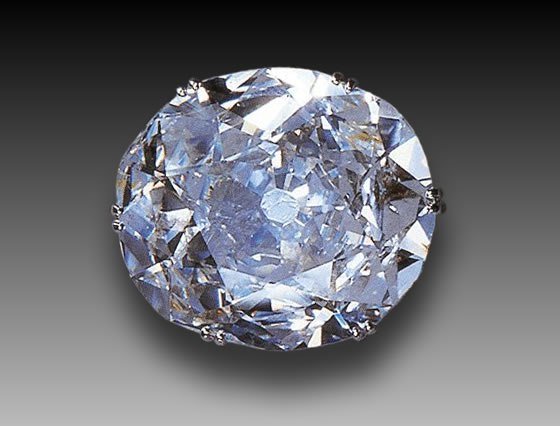
The Koh-i-Noor diamond is another treasure found in the British crown jewels, set in the ‘Crown of Queen Elizabeth, the Queen Mother’. Believed to have mined in the 13th century the Koh-i-Noor was originally182ct, but over the years it has beenaltered and modified to perfect its shape. In 1852 Prince Albert ordered the massive diamond to be recut – after much consultation – and the resulting diamond had been reduced by a huge 42%, making the new shape 105.60ct. This cost an astonishing £8,000, took 38 twelve hour days and concluded with a less than satisfying cut diamond. Before Victoria’s death, the diamond was mounted in to a brooch which was kept at Windsor Castle, rather than the Tower with the rest of the crown jewels. After Victoria’s death, Queen Alexandra had the diamond mounted in to her crown, followed by Queen Mary and finally Queen Elizabeth (Queen Mother). The platinum crown in which it is now set, was designed and crafted by Garrard for the 1937 coronation of King George VI.
Star Of India

Not many people know or understand the phenomenon of ‘stars’ in gemstones. The effect termed asterism is beautiful and rare. The Star of India is a mammoth 563.35ct sapphire and is about the size of a golf ball. The star effect is caused by rutile needles formed in a 3-fold arrangement. When the light bounces off them, the result is this outstanding six-pointed star.
J.P. Morgan, a wealthy financier, appointed gem expert George Kunz to create an impressive gem collection for the Paris Exhibition of 1900. Although the gem is known as originating from Sri Lanka, no other history or provenance is established, other than Kunz writing in 1913 that the “Star of India has a more or less indefinite historic record of some three centuries”. After exhibit, the entire collection was donated to the American Museum of Natural History, where the gem still resides today. In 1964 the sapphire suffered some drama, when a group of robbers were able to steal it from its case due to a defunct battery on the alarm. Although the culprits were detained within two days, it wasn’t until January 1965 that they gave up the location of the gems and the uninsured Star of India was able to return to its rightful location.
Rosser Reeves Ruby
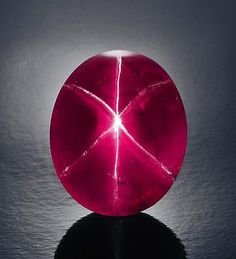
Donated to the Smithsonian in 1965 by its namesake Rosser Reeves, this Sri Lankan beauty weighs 138.72ct and is one of the world’s finest and largest star ruby. Reeves carried the ruby around as his lucky token and even referred to it as his “baby”. Buying the ruby in the mid-1950’s, the jewel had recently lost a few carats during re-polishing, shrinking from just over 140ct to its current weight. The polishing not only removed the heavy scratches but also centred the star making it even more fabulous.
Andamooka Opal (The Queen’s Opal)

This fabulous jewel was presented to Queen Elizabeth II on her visit to South Australia in 1954. Discovered in 1949 in the South Australian Andamooka mine, a lapidarist named John Altmann cut and polished the opal to its 203ct oval shape.
The jewel was mounted in to an intricate palladium and diamond necklet mount. A matching pair of earrings were also crafted to create a demi-parure. It is still considered one of the finest opals ever found, for not only its large size, but intensity of its play of colour.
Pearl Of Lao Tzu
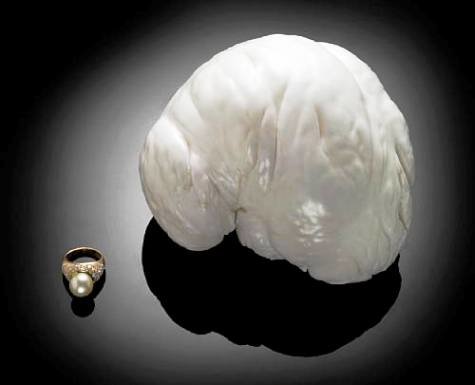
Considered a ‘non-nacreous’ pearl by gemmologists, the Pearl of Lao Tzu originates from a giant clam and is the largest pearl known in the world. “Gem” pearls have what is described as pearlescence, which is the beautiful shining colours seen in its ‘skin’. A Tridacna clam has no mother of pearl in its shell, but rather something called porcellaneous which is like white china. The pearl was found by a Filipino diver in the Palawan sea and weighs 6.40kg! The American who purchased the pearl gave two varying stories as to how it came in to his possession, but either way his death in 1979 saw the pearl sell for $200,000. Currently the pearl is being held in a probate estate with three equal share-owners fighting over it. Varying valuations have been offered on the pearl, ranging from $35million-$60million.
Hooker Emerald
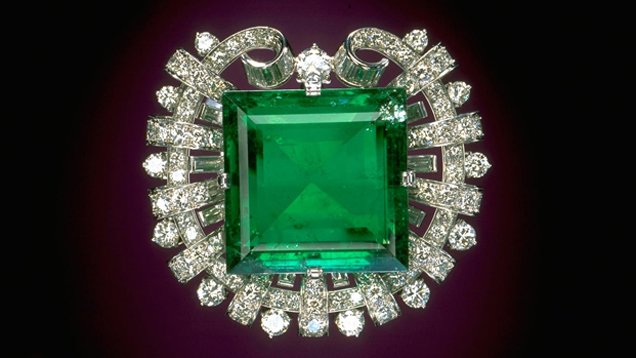
Boasting exceptional depth of colour and extraordinary clarity, the Hooker Emerald weighs 75.57ct and is currently displayed in the Smithsonian Museum of Natural History. Set in a lavish Tiffany & Co design, the host brooch is crafted in platinum with approximately 13ct of diamonds. Mined in the 16th or 17th century in Columbia, Spanish conquistadors had the rough emerald sent to Europe to be fashioned. It was subsequently sold to the Ottoman Empire. Rumours say that during 1908 when Abdul Hamid II had many of the crown jewels smuggled to Pair, the Hope Diamond also accompanied them. Hoping to be able to recover enough money to repay his debts, Habib auctioned the gems in 1911 and Tiffany took ownership of this magnificent emerald. They retained the jewel – initially set in a tiara – until 1950 when it was remounted in to a brooch design. In 1955 philanthropic heiress Janet Annenberg Hooker purchased the piece. After 22 years of enjoyment, she donated the brooch to the Smithsonian Institution.
